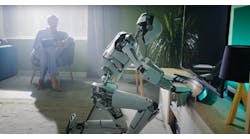How collaborative robots can solve the labor-shortage problem
For a long time, automation was essentially deployed. The manufacturing process was designed around the automation. A robot was a custom implementation, which included sensors and PLCs. Bring it all together, code it and switch it on.
“You were essentially designing your world around an instance of automation,” says Jim Lawton, chief operating officer at Rethink Robotics, which created the Intera-software-powered Baxter and Sawyer collaborative robots. “And then you have an instance of automation that does that single thing and is very rigid. But this new breed of collaborative robots works in the environment that you already have.”
By using cobots, one can introduce automation into an existing manufacturing work cell to save time and money in the short and long terms.
Break the injection mold
Tennplasco, the Tennessee-based plastic injection molding division of Manar, was able to solve its labor shortage problem by deploying Rethink’s Sawyer robot. Tennplasco was not only able to solve a portion of its labor problem, but it also received a return on investment in just three-and-a-half months.
“We were having a very difficult time to get people to work, especially on the off shifts, on the injection molding floor,” Danny Rose, general manager at Tennplasco, says. “Our customers, were trusting us to be able to support their businesses, so we had a find a way to meet their needs.”
Tennplasco’s situation is typical of most manufacturers, in that many struggle with not having enough talented workforce to be able to extend operations around the clock, explains Lawton. “Manufacturers are always on the lookout for solutions that help them to figure out how to do more with less,” he says. “With Sawyer, we were able to come in and show the robot what to do, just like you would with a person. That results in a very fast deployment.”
In this particular case, Tennplasco needed a robot that could fulfill an injection-molded operation combined with a machine-tending task within an existing work cell. Sawyer, which was up and running in manner of single-digit days at Tennplasco, was an ideal candidate for this kind of cobot.
Because injection-molded parts tend to be light, cobots are an ideal, safe solution. Collaborative robots work in the domain of trade-offs between the weight of the part, the speed it needs to move and the length of the robot’s arm. A cobot was ideal for Tennplasco’s needs because of the need for machine tending on its welding equipment. Utilization of the capital equipment was higher, and it allowed the robot’s human coworker to be more productive by eliminating the need for an operator to wait for the welding machine to finish its task. In this particular case, Tennplasco had four people in this work cell, but now it only requires two after bringing in Sawyer.
Hand in hand
To make the deployment possible, Rethink started by breaking down exactly what the human operators do with their hands. The type of hand movements that are necessary are a critical driver of whether or not a collaborative robot is an appropriate solution. While humans are extraordinarily dexterous and are able to do radically different hand movements in a short amount of time, the same can’t be said of a robot.
Crystal Coast Machine in New Bern, North Carolina, was then hired to create a pneumatic end effector that would allow Sawyer to pick what it needs to part up easily and securely. The end effector is a little wide to accommodate the dashboard-length defroster nozzle component it was brought in to help to manufacture. Determining the right kind of end effector was an important element of the integration, says Lawton.
The Sawyer robot must also inspect the part as it’s assembled to ensure that all the components are where they need to be. There were two pieces of foam installed and a label. This was accomplished by using a Cognex camera that was installed on the robot’s wrist to ensure everything is properly aligned.
Not just another pretty face
Because the robot and the person must work closely together, Lawton says it’s important to understand exactly how the worker and robot will interact and communicate with each other. “Is this going to hurt me?”
Lawton has found that the first time a person interacts with a piece of automation they ask this question—sometimes out loud, but mostly subconsciously. To make the experience as seamless as possible, Rethink puts a lot of thought into the robot's movements and appearance. Sawyer has springs in every joint; it has a control system that detects forces any place on the arm, so if it bumps into a person, it is able to flex on contact. Its control system reacts and stops the robot from moving if it contacts something it wasn’t expecting to be there. If someone is afraid to use the robot, that’s going to make the integration challenge that much greater.
One method for fighting that fear is through the addition of a face and eyes. Even more important is that each robot is built with anticipatory artificial intelligence. The robot uses its knowledge of where its arm is about to go to turn its head in the direction of where it is, providing a visual cue for operators that the arm is about to move. This is meant to mimic how humans interact with each other and build trust. For example, if two people were sitting across from each other with a drink between them on the table, the person going to grab the drink would first glance at the drink and then grab it.
“Subconsciously you’re getting comfortable that when my arm moved it wasn’t a surprise since you saw my eyes move in the direction of where the arm was about to move before my arm actually moved,” Lawton says. It’s that kind of thing that’s built into the robot to make the human interaction with them more comfortable.
“Initially, especially with Sawyer, there was some anxiousness because it was new,” Tennplasco’s Rose says. “But the people have been very accepting of him. They like seeing his face and eyes and being able to interact with him.”
If you’re at a place where you have labor challenges or if there are people doing jobs that are not particularly excited by them because they’re boring or unsafe, those are all ideal candidates for a collaborative robot, Lawton says. “You don’t have to deploy a thousand at a time,” he explains. “You can deploy one at a time, get some experience and move onto the next. If you have an existing manufacturing plant and one of your challenges is not having enough labor, chances are there’s something in your factory that a cobot can do. For Tennplasco, the focus is on where we are going to deploy the next robot.”
ALSO READ: Who’s that new robot on second shift?
Christopher James Palafox is the digital managing editor for Control Design and Pharmaceutical Manufacturing. He has experience editing and writing for multiple industries, including construction, design, architecture, business and information technology. Email him at [email protected].

Leaders relevant to this article:



